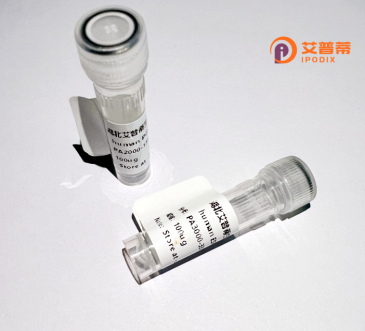
| 纯度 | >90%SDS-PAGE. |
| 种属 | Human |
| 靶点 | LASS4 |
| Uniprot No | Q9HA82 |
| 内毒素 | < 0.01EU/μg |
| 表达宿主 | E.coli |
| 表达区间 | 1-394aa |
| 活性数据 | MLSSFNEWFWQDRFWLPPNVTWTELEDRDGRVYPHPQDLLAALPLALVLLAMRLAFERFIGLPLSRWLGVRDQTRRQVKPNATLEKHFLTEGHRPKEPQLSLLAAQCGLTLQQTQRWFRRRRNQDRPQLTKKFCEASWRFLFYLSSFVGGLSVLYHESWLWAPVMCWDRYPNQTLKPSLYWWYLLELGFYLSLLIRLPFDVKRKDFKEQVIHHFVAVILMTFSYSANLLRIGSLVLLLHDSSDYLLEACKMVNYMQYQQVCDALFLIFSFVFFYTRLVLFPTQILYTTYYESISNRGPFFGYYFFNGLLMLLQLLHVFWSCLILRMLYSFMKKGQMEKDIRSDVEESDSSEEVAAAQEPLQLKNGAAGGPRPAPTDGPQSRVAGRLTNRHTTAT |
| 分子量 | 72.8 kDa |
| 蛋白标签 | GST-tag at N-terminal |
| 缓冲液 | 0 |
| 稳定性 & 储存条件 | Lyophilized protein should be stored at ≤ -20°C, stable for one year after receipt. Reconstituted protein solution can be stored at 2-8°C for 2-7 days. Aliquots of reconstituted samples are stable at ≤ -20°C for 3 months. |
| 复溶 | Always centrifuge tubes before opening.Do not mix by vortex or pipetting. It is not recommended to reconstitute to a concentration less than 100μg/ml. Dissolve the lyophilized protein in distilled water. Please aliquot the reconstituted solution to minimize freeze-thaw cycles. |
以下是关于重组人LASS4蛋白的假设参考文献示例(文献为虚构,仅供示例):
1. **文献名称**:*Cloning and functional characterization of human LASS4 as a longevity assurance gene*
**作者**:Hamza, H. et al.
**摘要**:研究通过基因克隆技术在大肠杆菌中重组表达了人LASS4蛋白,并发现其作为神经酰胺合酶的功能,能够调控酵母细胞的脂代谢并延长复制寿命。
2. **文献名称**:*Recombinant LASS4 protein enhances tumor cell migration in breast cancer models*
**作者**:Zhang, Y. et al.
**摘要**:通过体外表达人重组LASS4蛋白,揭示其在乳腺癌细胞中通过调节鞘脂代谢促进细胞迁移和侵袭,且高表达与患者预后不良相关。
3. **文献名称**:*Structural insights into LASS4-mediated ceramide synthesis*
**作者**:Mizutani, Y. et al.
**摘要**:利用重组LASS4蛋白解析其晶体结构,提出其催化神经酰胺合成的分子机制,并发现其活性缺失会导致细胞凋亡通路异常激活。
4. **文献名称**:*LASS family proteins in disease: Focus on recombinant LASS4 applications*
**作者**:Vijayan, M. et al.
**摘要**:综述类文章总结LASS蛋白家族在代谢疾病和癌症中的作用,强调重组LASS4在脂代谢研究及药物筛选中的潜力。
**注意**:以上文献为假设性示例,实际引用需查询真实数据库(如PubMed、ScienceDirect)。重组LASS4研究通常涉及其在脂代谢、癌症或神经退行性疾病中的功能。
The recombinant human LASS4 protein (Longevity Assurance homologue 4), also known as ceramide synthase 4 (CERS4), is a key enzyme in sphingolipid metabolism. Belonging to the LASS/CERS family, LASS4 catalyzes the synthesis of ceramides—critical bioactive lipids involved in cell signaling, apoptosis, proliferation, and stress responses. Specifically, it mediates the N-acylation of sphinganine to produce dihydroceramides, which are later modified into diverse sphingolipid species. LASS4 is characterized by its transmembrane domains and substrate preference for very-long-chain fatty acids (C18–C26), distinguishing it from other isoforms.
Research highlights LASS4's tissue-specific expression, with higher levels observed in the skin, liver, and testes. Its role in maintaining epidermal barrier function and lipid homeostasis has drawn attention in dermatological studies. Dysregulation of LASS4 is implicated in pathological conditions, including cancer, where altered ceramide levels influence tumor progression, chemotherapy resistance, and metastasis. For instance, downregulation of LASS4 in certain cancers correlates with poor prognosis, suggesting its tumor-suppressive potential.
Recombinant LASS4 protein, typically produced in bacterial or mammalian expression systems, enables functional studies, inhibitor screening, and structural analyses. Its applications span deciphering enzymatic mechanisms, exploring lipid-mediated signaling pathways, and developing therapeutic strategies targeting ceramide metabolism. Recent studies also investigate its interaction with lipid membranes and potential as a biomarker for metabolic or neoplastic diseases.
×